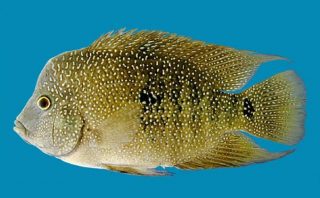
Well-meaning fishermen, and perhaps some aquarists, have helped this feisty and tasty species into many of the river systems of central and south Texas. How it ever got in the little intermittent stream we call Medio Creek, will remain a mystery. In good light, the whitish spots on the Texas Cichlid “glow” an iridescent turquoise, making it a favorite species for aquarium-keepers. Chad Thomas photo.
08 Jul 2016 – Mystery in the Medio
I wanted some Mosquito Fish for my small waterlily pond. These little minnows eat mosquito larvae. Mosquito Fish are a natural way to keep mosquitos from breeding in your pond water. However, I have never found any of these little fishes for sale.
I remembered seeing Mosquito Fish in the shallow water of local creeks. I figured we could net a few of the tiny fish and transplant them to our pond. I got out the little dip net I use in my aquarium. Then I talked my husband into checking out Medio Creek with me.
To my surprise, he was keen on the idea. He got out the cast net. In fact, he got out his tackle box and rod-and-reel. He rigged up a rod-and-reel for me. He went to Wal-Mart and bought nightcrawlers for bait. No matter that the worms were bigger than the Mosquito Fish! He was getting into this expedition.
On a hot July afternoon, we drove to the old iron bridge on Highway 59. The Medio usually has water there. In the shade of the new bridge, I waded into the water’s edge, looking for minnows. I saw a few, very tiny ones. I tried to catch them with my hands (I had forgotten the dip net, of course) but had no luck. I gave up and walked over to where Robert was baiting a hook.
He cast his line out into a deeper pool of water about 10 feet from the shore. Whammo! Something grabbed his hook and jerked the bobber under. This was no minnow!
He reeled it in and I saw immediately that it was a Rio Grande Perch. It had the deep, flat body of a sunfish. Its color was pale gray with five vertical black bars on its sides. In the sunlight, I could see the fish sparkled with iridescent turquoise spots.

Imagine the ancient super-continent of Gondwanaland. The pugnacious ancestors of today’s cichlids were scattered in lakes and rivers on both sides of the line that would be the future Atlantic coastlines of South America and Africa (red area). About 180 million years ago, South America and Africa began drifting apart, breaking the genetic connection between the fishes. One species of cichlid eventually made its way to south Texas and became what used to be known as the Rio Grande Perch. Robert Benson map.
It had been years since I had seen a Rio Grande Perch. I remembered seeing them in the clear streams that run though the University of Texas campus in Austin. (I was a “biology major” so I noticed such things.) The perch bred in the campus creeks. I could see their nests: shallow, pebble-filled depressions each guarded by an adult fish. The babies were as cute as buttons! I caught one of the inch-long fry and kept it in an aquarium. It grew surprisingly fast; within six months it was as big as my hand. I released it back in the creek.
The Rio Grande Perch is also known as the Texas Cichlid (pronounced “sick-lid”). Texas Cichlids are tropical fish. They cannot survive water temperatures colder than 49 degrees Fahrenheit. They used to be found only in the Rio Grande drainage of South Texas and northern Mexico. During the last 170 years, the fish were released multiple times into spring-fed creeks and rivers where the water temperature remains constant year round. This has led to thriving Texas Cichlid populations in many other areas of Texas.
The Texas Cichlid (Herichthys cyanoguttatus) is the only native cichlid in the United States. But the cichlid family is huge; it contains over 1650 species worldwide. Scientists estimate that a thousand more may exist.
Where do all these cichlids come from? Almost all cichlid species originate in Africa and South America. You may know that these two continents were once part of an ancient “super-continent” known as Gondwanaland. Gondwanaland broke apart about 180 million years ago forming the Atlantic Ocean and the two modern continents. However, the ancestors of the cichlid family of fishes had already evolved. Thus, all the cichlids are closely related even though now found on separate continents.
What makes a cichlid a cichlid? The distinguishing characteristic shared by all cichlids is the pharyngeal teeth found in their throats. These teeth allow the fish to grab food with their regular teeth and then “chew” it further down their gullets. Therefore, cichlids can eat more and eat faster. This is probably one reason why they are so successful a family.
It is a mystery to me how a Texas Cichlid wound up in Medio Creek. We are a long way from the Rio Grande. And doesn’t the Medio get cold in winter? Even though Texas Cichlids were introduced into some Hill Country rivers, Austin area creeks, and the San Antonio River, none of these waterways connect to Medio Creek. The Medio has its source in north Bee County. It joins up with Blanco Creek in the southern part of the county. The two creeks become the Mission River. The short Mission empties into Copano Bay on the Gulf of Mexico.
Cichlids are freshwater fishes. However, they can stand saltwater influxes better than many kinds of fish. Is it possible that some Texas Cichlids washed down to the bays from a flooding San Antonio or Guadalupe River and then swam up the Mission River to the Medio? Maybe. Or maybe someone released an overly pugnacious aquarium specimen into Medio Creek.
Cichlids are very aggressive fish. They run off or kill almost all other fish species in their vicinity, especially during the breeding season. Aquarists have learned that they can keep only a single cichlid, or a mated pair, in an aquarium. Since they are so beautiful and so diverse, cichlids are quite popular aquarium fishes. The turquoise-dotted Texas Cichlid is a favorite.
Sadly, aquarium releases have resulted in the native Texas Cichlid becoming an invasive species in the warmer parts of the United States. The rapidly breeding, aggressive Texas Cichlids are pushing out many of the native species in the waterways of Florida and southern Louisiana. Fortunately, Texas Cichlids are quite good to eat. Competitions to catch the most cichlids, like the one held in New Orleans’ City Park, may help to get the species under control. Cajun blackened cichlid, anyone?
If you would like to offer comments, please click through to the discussion page
